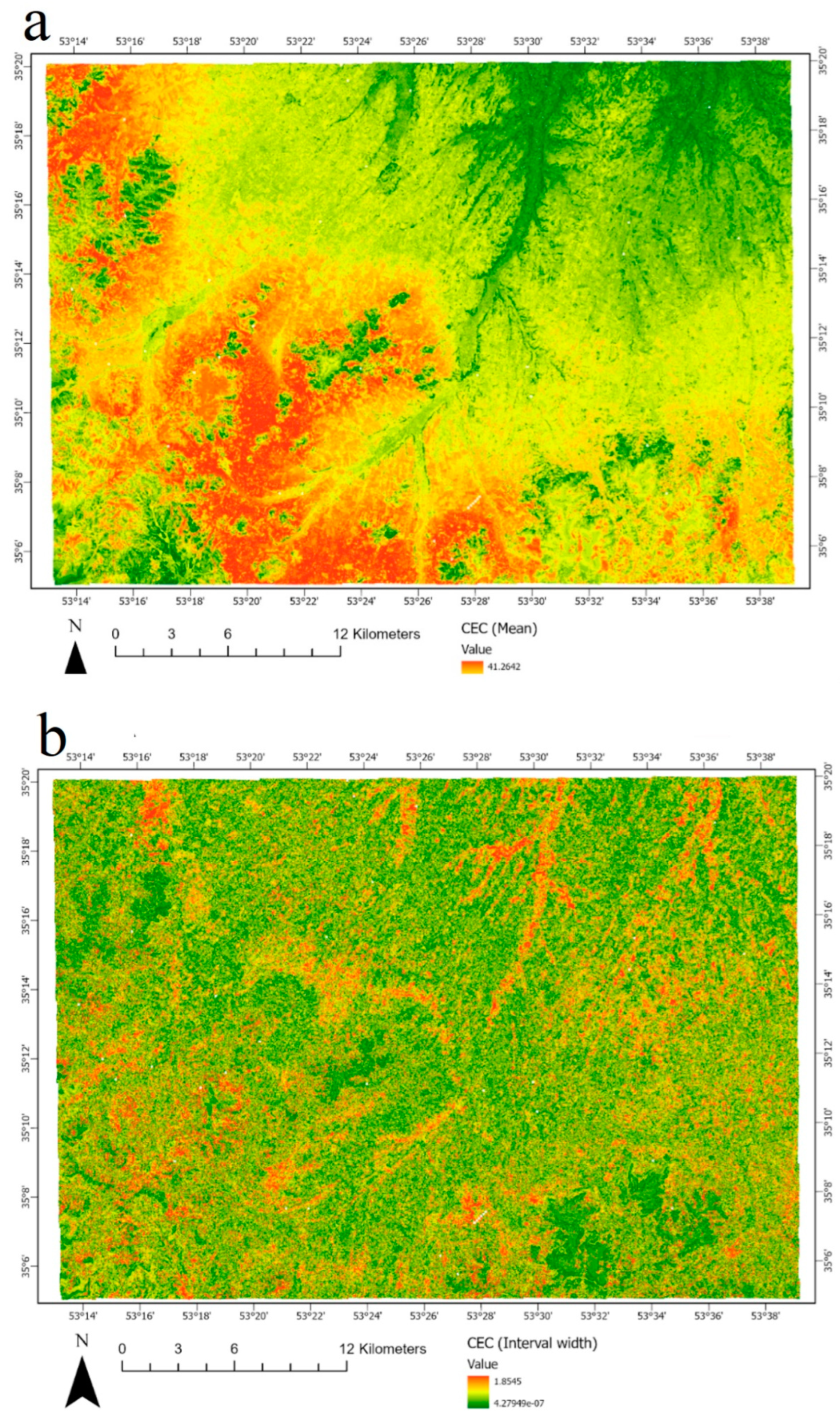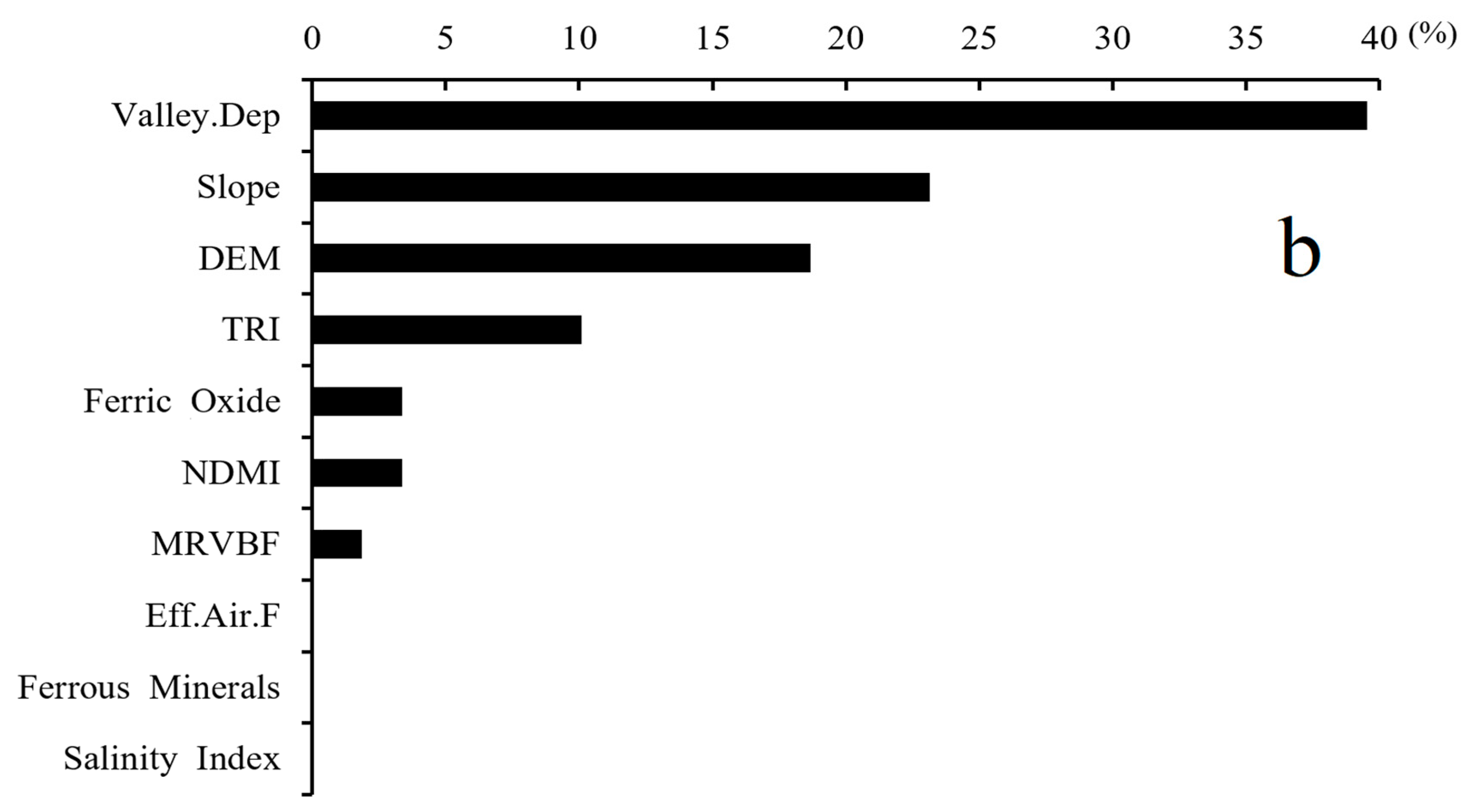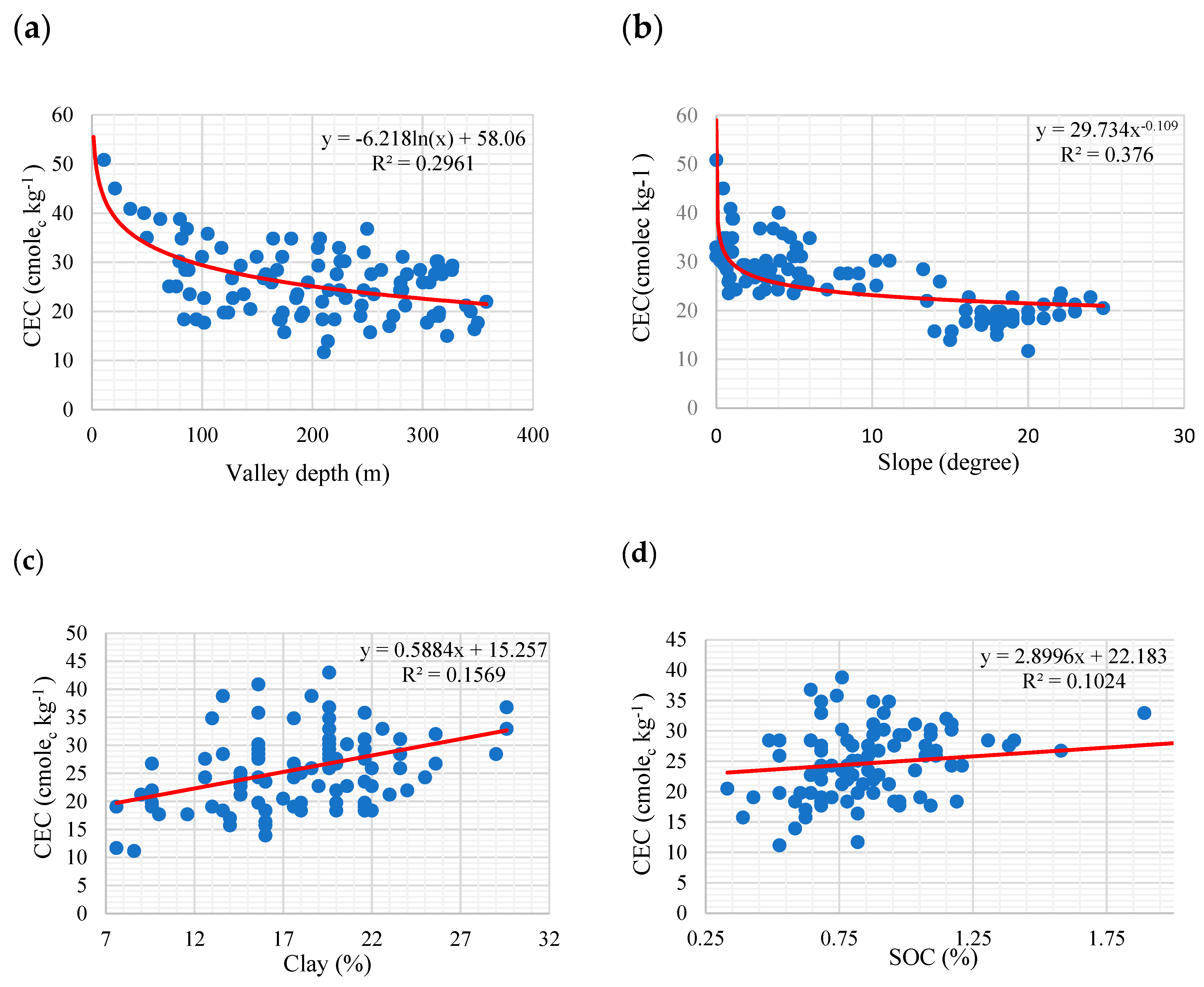Comparison of Different Machine Learning Methods for Predicting Cation Exchange Capacity Using Environmental and Remote Sensing Data
Abstract
:1. Introduction
2. Materials and Methods
2.1. Study Area and Soil Sampling
2.2. Environmental Covariates
2.3. Preprocessing for Environmental Variables and Feature Selection
2.4. Modeling Approaches
2.5. Assessment of Models
3. Results and Discussion
3.1. Variability of CEC, Soil Properties, and XRD Analyses
3.2. Modeling and Spatial Prediction of CEC
3.3. Variable Important Analysis
4. Conclusions
Author Contributions
Funding
Institutional Review Board Statement
Data Availability Statement
Acknowledgments
Conflicts of Interest
References
- Huang, J.; Barrett-Lennard, E.; Kilminster, T.; Sinnott, A.; Triantafilis, J. An Error Budget for Mapping Field-Scale Soil Salinity at Various Depths using Different Sources of Ancillary Data. Soil Sci. Soc. Am. J. 2015, 79, 1717–1728. [Google Scholar] [CrossRef]
- Palansooriya, K.N.; Shaheen, S.M.; Chen, S.S.; Tsang, D.C.W.; Hashimoto, Y.; Hou, D.; Bolan, N.S.; Rinklebe, J.; Ok, Y.S. Soil amendments for immobilization of potentially toxic elements in contaminated soils: A critical review. Environ. Int. 2020, 134, 105046. [Google Scholar] [CrossRef] [PubMed]
- Juhos, K.; Madarász, B.; Kotroczó, Z.; Béni, A.; Makádi, M.; Fekete, I. Carbon sequestration of forest soils is reflected by changes in physicochemical soil indicators—A comprehensive discussion of a long-term experiment on a detritus manipulation. Geoderma 2021, 385, 114918. [Google Scholar] [CrossRef]
- Triantafilis, J.; Kerridge, B.; Buchanan, S.M. Digital Soil-Class Mapping from Proximal and Remotely Sensed Data at the Field Level. Agron. J. 2009, 101, 841–853. [Google Scholar] [CrossRef]
- Lyu, H.; Watanabe, T.; Sugimoto, S.; Kilasara, M.; Funakawa, S. Control of climate on soil charge characteristics through organic matter and clay mineral distributions in volcanic soils of Mt. Kilimanjaro, Tanzania. Soil Sci. Plant Nutr. 2021, 67, 288–300. [Google Scholar] [CrossRef]
- Sufian, O. Adsorption: An Important Phenomenon in Controlling Soil Properties and Carbon Stabilization. In Soil Carbon Stabilization to Mitigate Climate Change; Datta, R., Meena, R.S., Eds.; Springer: Singapore, 2021; pp. 205–241. [Google Scholar]
- Rhoades, J.D. Cation Exchange Capacity. In Methods of Soil Analysis: Part 2 Chemical and Microbiological Properties, 2nd ed.; Page, A.L., Ed.; Wiley: New York, NY, USA, 1983; Volume 9, pp. 167–179. [Google Scholar]
- Toomanian, N.; Jalalian, A.; Eghbal, M.K. Genesis of gypsum enriched soils in north-west Isfahan, Iran. Geoderma 2001, 99, 199–224. [Google Scholar] [CrossRef]
- McBratney, A.B.; Minasny, B.S.; Cattle, R.; Vervoort, R.W. From pedotransfer function to soil interference systems. Geoderma 2002, 93, 225–253. [Google Scholar]
- Vereecken, H.; Weynants, M.; Javaux, M.; Pachepsky, Y.; Schaap, M.G.; Van Genuchten, M.T. Using pedotransfer functions to estimate the van Genuchten-Mualem soil hydualic peopoeties: A review. Vdose Zone J. 2010, 9, 795–820. [Google Scholar] [CrossRef]
- Asadzadeh, F.; Maleki-Kakelar, M.; Shabani, F. Predicting Cationic Exchange Capacity in Calcareous Soils of East-Azerbaijan Province, Northwest Iran. Commun. Soil Sci. Plant Anal. 2019, 50, 1106–1116. [Google Scholar] [CrossRef]
- Castrignanò, A.; Giugliarini, L.; Risaliti, R.; Martinelli, N. Study of spatial relationships among some soil physico-chemical properties of a field in central Italy using multivariate geostatistics. Geoderma 2000, 97, 39–60. [Google Scholar] [CrossRef]
- Mueller, T.G.; Pierce, F.J.; Schabenberger, O.; Warncke, D.D. Map Quality for Site-Specific Fertility Management. Soil Sci. Soc. Am. J. 2001, 65, 1547–1558. [Google Scholar] [CrossRef]
- Jung, W.K.; Kitchen, N.R.; Sudduth, K.A.; Anderson, S.H. Spatial Characteristics of Claypan Soil Properties in an Agricultural Field. Soil Sci. Soc. Am. J. 2006, 70, 1387–1397. [Google Scholar] [CrossRef]
- Kitchen, N.R.; Sudduth, K.A.; Myers, D.B.; Drummond, S.T.; Hong, S.Y. Delineating productivity zones on claypan soil fields using apparent soil electrical conductivity. Comput. Electron. Agric. 2005, 46, 285–308. [Google Scholar] [CrossRef]
- Zeraatpisheh, M.; Ayoubi, S.; Sulieman, M.; Rodrigo-Comino, J. Determining the spatial distribution of soil properties using the environmental covariates and multivariate statistical analysis: A case study in semi-arid regions of Iran. J. Arid Land 2019, 11, 551–566. [Google Scholar] [CrossRef]
- Triantafilis, J.; Lesch, S.M.; Lau, K.L.; Buchanan, S.M. Field level digital soil mapping of cation exchange capacity using electromagnetic induction and a hierarchical spatial regression model. Aust. J. Soil Res. 2009, 47, 651–663. [Google Scholar] [CrossRef]
- Taghizadeh, R.; Minasny, B.; Malone, B. Digital mapping of cation exchange capacity using genetic programming and soil depth functions in Baneh region. Iran. Arch. Agron. Soil Sci. 2016, 62, 109–126. [Google Scholar] [CrossRef]
- Nussbaum, M.; Spiess, K.; Baltensweiler, A.; Grob, U.; Keller, A.; Greiner, L.; Schaepman, M.E.; Papritz, A. Evaluation of digital soil mapping approaches with large sets of environmental covariates. Soil 2018, 4, 1–22. [Google Scholar] [CrossRef]
- Sorenson, P.T.; Shirtliffe, S.J.; Bedard-Haughn, A.K. Predictive soil mapping using historic bare soil composite imagery and legacy soil survey data. Geoderma 2021, 401, 115316. [Google Scholar] [CrossRef]
- Soil Survey Staff. Keys to Soil Taxonomy, 12th ed.; USDA-Natural Resources Conservation Service: Washington, DC, USA, 2014. [Google Scholar]
- Zahedi, M.; Hajian, J.; GSI. The Geological Map; Zahedi, M., Hajian, J., Eds.; Cartographic Department of Geological Survey of Iran: Tehran, Iran, 1985. [Google Scholar]
- Gee, G.; Bauder, J. Particle-size analysis. In Methods of Soil Analysis, Part 1. Agronomy Monograph 9; Klute, A., Ed.; American Statistical Association and Soil Science Society of America: Madison, WI, USA, 1986; pp. 383–411. [Google Scholar]
- Nelson, D.W.; Sommers, L.E. Total carbon, organic carbon, and organic matter. In Methods of Soil Analysis: Part 2, Chemical and Microbiological Properties; The American Society of Agronomy: Madison, WI, USA, 1982; pp. 539–579. [Google Scholar]
- Moore, D.M.; Reynolds, R.C., Jr. X-ray Diffraction and the Identification and Analysis of Clay Minerals, 2nd ed.; Oxford University Press: New York, NY, USA, 1997. [Google Scholar]
- Wu, Y.Z.; Chen, J.; Ji, J.F.; Tian, Q.J.; Wu, X.M. Feasibility of reflectance spectroscopy for the assessment of soil mercury contamination. Environ. Sci. Technol. 2005, 39, 873–878. [Google Scholar] [CrossRef]
- Ließ, M.; Schmidt, J.; Glaser, B. Improving the spatial prediction of soil organic carbon stocks in a complex tropical mountain landscape by methodological specifications in machine learning approaches. PLoS ONE 2016, 11, e0153673. [Google Scholar] [CrossRef]
- Chen, W.; Panahi, M.; Pourghasemi, H.R. Performance evaluation of GIS-based new ensemble data mining techniques of adaptive neuro-fuzzy inference system (ANFIS) with genetic algorithm (GA), differential evolution (DE), and particle swarm optimization (PSO) for landslide spatial modelling. Catena 2017, 157, 310–324. [Google Scholar] [CrossRef]
- Keskin, H.; Grunwald, S.; Harris, W.G. Digital mapping of soil carbon fractions with machine learning. Geoderma 2018, 339, 40–58. [Google Scholar] [CrossRef]
- Kursa, M.B.; Jankowski, A.; Rudnicki, W.R. Boruta—A system for feature selection. Fundam. Inform. 2010, 101, 271–285. [Google Scholar] [CrossRef]
- R Development Core Team. R: A Language and Environment for Statistical Computing; R Foundation for Statistical Computing: Vienna, Austria, 2015; Available online: http://www.R-project.org (accessed on 17 August 2022).
- Wu, X.; Kumar, V.; Ross Quinlan, J.; Ghosh, J.; Yang, Q.; Motoda, H.; McLachlan, G.J.; Ng, A.; Liu, B.; Yu, S.P.; et al. Top 10 algorithms in data mining. Knowl. Inf. Syst. 2008, 14, 1–37. [Google Scholar] [CrossRef]
- Vapnik, V. The Nature of Statistical Learning Theory; Wiley Press: New York, NY, USA, 1995. [Google Scholar]
- Liaw, A.; Wiener, M. Classification and regression by random Forest. R News 2002, 2, 18–22. [Google Scholar]
- Quinlan, J.R. Learning with continuous classes. In Proceedings of the 5th Australian joint conference on artificial intelligence, Hobart, Tasmania, 16–18 November 1992; Volume 92, pp. 343–348. [Google Scholar]
- Malone, B.P.; Odgers, N.P.; Stockmann, U.; Minasny, B.; McBratney, A.B. Digital mapping of soil classes and continuous soil properties. In Pedometrics; McBratney, A.B., Minasny, B., Stockmann, U., Eds.; Springer International Publishing: Cham, Switzerland, 2018; pp. 373–413. [Google Scholar]
- Hengl, T.; Heuvelink, G.B.; Kempen, B.; Leenaars, J.G.; Walsh, M.G.; Shepherd, K.D.; Sila, A.; MacMillan, R.A.; Mendes de Jesus, J.; Tamene, L.; et al. Mapping soil properties of Africa at 250 m resolution: Random forests significantly improve current predictions. PLoS ONE 2015, 10, e0125814. [Google Scholar]
- Yang, R.-M.; Guo, W.-W. Modelling of soil organic carbon and bulk density in invaded coastal wetlands using Sentinel-1 imagery. Int. J. Appl. Earth Obs. Geoinf. ITC J. 2019, 82, 101906. [Google Scholar] [CrossRef]
- Reganold, J.P.; Harsh, J.B. Expressing cation exchange capacity in milliequivalents per 100 grams and in SI units. J. Agron. Educ. 1985, 14, 84–90. [Google Scholar] [CrossRef]
- Khaledian, Y.; Quinton, J.N.; Brevik, E.C.; Pereira, P.; Zeraatpisheh, M. Developing global pedotransfer functions to estimate available soil phosphorus. Sci. Total Environ. 2018, 644, 1110–1116. [Google Scholar] [CrossRef]
- Wang, J.; Ding, J.; Yu, D.; Ma, X.; Zhang, Z.; Ge, X.; Teng, D.; Li, X.; Liang, J.; Lizaga, I.; et al. Capability of Sentinel-2 MSI data for monitoring and mapping of soil salinity in dry and wet seasons in the Ebinur Lake region, Xinjiang, China. Geoderma 2019, 353, 172–187. [Google Scholar] [CrossRef]
- Tajik, S.; Ayoubi, S.; Zeraatpisheh, M. Digital mapping of soil organic carbon using ensemble learning model in Mollisols of Hyrcanian forests, northern Iran. Geoderma Reg. 2020, 20, e00256. [Google Scholar] [CrossRef]
- Wadoux, A.M.C.; Brus, D.J.; Heuvelink, G.B. Sampling design optimization for soil mapping with random forest. Geoderma 2019, 355, 113913. [Google Scholar] [CrossRef]
- Zeraatpisheh, M.; Jafari, A.; Bodaghabadi, M.B.; Ayoubi, S.; Taghizadeh-Mehrjardi, R.; Toomanian, N.; Kerry, R.; Xu, M. Conventional and digital soil mapping in Iran: Past, present, and future. Catena 2019, 188, 104424. [Google Scholar] [CrossRef]
- Gverić, Z.; Rubinić, V.; Kampić, Š.; Vrbanec, P.; Paradžik, A.; Tomašić, N. Clay mineralogy of soils developed from Miocene marls of Medvednica Mt., NW Croatia: Origin and transformation in temperate climate. Catena 2022, 216, 106439. [Google Scholar] [CrossRef]
- Kowalska, J.B.; Vögtli, M.; Kierczak, J.; Egli, M.; Waroszewski, J. Clay mineralogy fingerprinting of loess-mantled soils on different underlying substrates in the south-western Poland. Catena 2021, 210, 105874. [Google Scholar] [CrossRef]
- Conrad, O.; Bechtel, B.; Bock, M.; Dietrich, H.; Fischer, E.; Gerlitz, L.; Wehberg, J.; Wichmann, V.; Bohner, J. System for Automated Geoscientific analyses (SAGA) v. 2.1.4. Geosci. Model Dev. 2015, 8, 1991–2007. [Google Scholar] [CrossRef]
- Li, Z.W.; Zhang, G.; Geng, R.; Wang, H. Spatial heterogeneity of soil detachment capacity by overland flow at a hillslope with ephemeral gullies on the Loess Plateau. Catena 2015, 248, 264–272. [Google Scholar] [CrossRef]
- Cerda, A.; Rodrigo-Comino, J. Is the hillslope position relevant for runoff and soil loss activation under high rainfall conditions in vineyards? Ecohydrol. Hydrobiol. 2020, 20, 59–72. [Google Scholar] [CrossRef]
- Jarecki, M.K.; Lal, R.; James, R. Crop management effects on soil carbon sequestration on selected farmers’ fields in northeastern Ohio. Soil Tillage Res. 2005, 81, 265–276. [Google Scholar] [CrossRef]
- Ben-Dor, E.; Chabrillat, S.; Demattê, J.; Taylor, G.; Hill, J.; Whiting, M.; Sommer, S. Using Imaging Spectroscopy to study soil properties. Remote Sens. Environ. 2009, 113, S38–S55. [Google Scholar] [CrossRef]
- Nocita, M.; Stevens, A.; Noon, C.; van Wesemael, B. Prediction of soil organic carbon for different levels of soil moisture using Vis-NIR spectroscopy. Geoderma 2013, 199, 37–42. [Google Scholar] [CrossRef]
- Oltra-Carrió, R.; Baup, F.; Fabre, S.; Fieuzal, R.; Briottet, X. Improvement of Soil Moisture Retrieval from Hyperspectral VNIR-SWIR Data Using Clay Content Information: From Laboratory to Field Experiments. Remote Sens. 2015, 7, 3184–3205. [Google Scholar] [CrossRef] [Green Version]











| Covariates | Definition | Reference |
|---|---|---|
| Band 1 (0.433–0.45 µm) | Reflectance value of Landsat satellite band | Landsat satellite |
| Band 2 (0.45–0515 µm) | Reflectance value of Landsat satellite band (Blue) | Landsat satellite |
| Band 3 (0525–0.605 µm) | Reflectance value of Landsat satellite band (Green) | Landsat satellite |
| Band 4 (0.63–0.69 µm) | Reflectance value of Landsat satellite band (Red) | Landsat satellite |
| Near-infrared (0.75–090 µm) | Reflectance value of Landsat satellite band (NIR) | Landsat satellite |
| Shortwave infrared (1.55–1.75 µm) | Reflectance value of Landsat satellite band (SWIR) | Landsat satellite |
| Normalized difference vegetation index (NDVI) | (NIR − Green)/(NIR + Green) | Foody et al., 2001 |
| Soil-adjusted vegetation index (SAVI) | ((NIR − Red)/(NIR + Red + L)) × (1 + L) | Huete, 1988 |
| Infrared percentage vegetation index (IPVI) | NIR/(NIR + Red) | Crippen, 1990 |
| Transformed difference vegetation index (TDVI) | (NIR − Red)/(NIR + Red) + 0.5 | Huete, 1988 |
| Normalized difference moisture index (NDMI) | (NIR − SWIR)/(NIR + SWIR) | Wilson et al., 2002 |
| Normalized difference snow index (NDSI) | (Red − NIR)/(Red + NIR) | Major et al., 1990 |
| Brightness index (BI) | ((Red × Red) + (NIR ×NIR))ˆ0.5 | Khan et al., 2005 |
| Salinity index | (Blue − Red)/(Blue + Red) | Douaoui et al., 2008 |
| Clay Mineral | (SWIR1/SWIR2) | Douaoui et al., 2008 |
| Ferrous Mineral | (SWIR1/NIR+Red) | Douaoui et al., 2008 |
| Ferrous Iron | (SWIR2/NIR)+ (Green/Red) | Douaoui et al., 2008 |
| Ferrous Silicates | (SWIR2/SWIR1) | Douaoui et al., 2008 |
| Ferric Iron | (Red/Green) | Douaoui et al., 2008 |
| Ferric Oxides | (SWIR1/NIR) | Douaoui et al., 2008 |
| Iron Oxide | (Red/Blue) | Douaoui et al., 2008 |
| Laterite | (SWIR1/SWIR2) | Douaoui et al., 2008 |
| Gossan | (SWIR1/Red) | Douaoui et al., 2008 |
| DEM (m) | Elevation | Conrad et al., 2015 |
| Aspect (degree) | Aspect area | Conrad et al., 2015 |
| CA | Catchment area | Conrad et al., 2015 |
| GC | General curvature | Conrad et al., 2015 |
| MrRTF | Multiresolution of ridge to flatness index | Conrad et al., 2015 |
| MrVBF | Multiresolution valley bottom flatness index | Conrad et al., 2015 |
| PlCu | Plan curvature | Conrad et al., 2015 |
| PrCu | Profile curvature | Conrad et al., 2015 |
| Slope gradient (degree) | Average gradient above flow path | Conrad et al., 2015 |
| TWI | Topographic wetness index | Conrad et al., 2015 |
| Valley depth (m) | Relative position of the valley | Conrad et al., 2015 |
| Effective air flow heights (m) | Calculates effective air flow heights | Conrad et al., 2015 |
| MBI | Mass balance index | Conrad et al., 2015 |
| Terrain ruggedness index (TRI) | Measures terrain ruggedness | Conrad et al., 2015 |
| Vertical distance to channel network (m) | Calculates the vertical distance to a channel network base level | Conrad et al., 2015 |
| Wind effect | Dimensionless index indicating areas exposed to wind | Conrad et al., 2015 |
| Wind exposition | Dimensionless index highlighting wind-exposed pixels | Conrad et al., 2015 |
| Geology map | Representing the various geological features | - |
| Geomorphology map | Representing the various geomorphic units | - |
| Variable | Unit | Min | Max | Mean | SD | CV (%) | Skewness | Kurtosis |
|---|---|---|---|---|---|---|---|---|
| SOC | % | 0.33 | 6.63 | 0.96 | 0.66 | 68.75 | 6.59 | 54.59 |
| CEC | cmolec kg−1 | 11.15 | 50.83 | 25.75 | 7.02 | 27.26 | 0.60 | 0.76 |
| pH | −log[H+] | 6.72 | 7.78 | 7.32 | 0.22 | 3.00 | −0.17 | 0.25 |
| EC | dS m−1 | 0.09 | 0.69 | 0.23 | 0.10 | 43.47 | 2.84 | 9.20 |
| Model | kNN | RF | SVM | Cu | |||
|---|---|---|---|---|---|---|---|
| Parameter | k | ntree | mtry | sigma | C | committees | neighbors |
| Value | 19 | 550 | 5 | 0. 3744 | 0.5 | 10 | 0 |
| Model | Training | Validation | ||||||||||||
|---|---|---|---|---|---|---|---|---|---|---|---|---|---|---|
| ME | RMSE | r2 | R2 | rhoC | RPD | RPIQ | ME | RMSE | r2 | R2 | rhoC | RPD | RPIQ | |
| RF | 0.01 | 2.74 | 0.93 | 0.86 | 0.9 | 2.67 | 3.74 | −0.7 | 5.15 | 0.41 | 0.34 | 0.43 | 1.25 | 1.49 |
| SVM | −0.52 | 4.47 | 0.67 | 0.62 | 0.73 | 1.64 | 2.3 | −1.29 | 5.35 | 0.34 | 0.29 | 0.45 | 1.21 | 1.44 |
| kNN | 0.59 | 6.38 | 0.24 | 0.23 | 0.36 | 1.15 | 1.61 | −0.49 | 5.72 | 0.19 | 0.18 | 0.32 | 1.13 | 1.34 |
| Cu | −0.11 | 4.89 | 0.56 | 0.55 | 0.68 | 1.5 | 2.1 | −1.02 | 4.51 | 0.53 | 0.49 | 0.64 | 1.43 | 1.71 |
Publisher’s Note: MDPI stays neutral with regard to jurisdictional claims in published maps and institutional affiliations. |
© 2022 by the authors. Licensee MDPI, Basel, Switzerland. This article is an open access article distributed under the terms and conditions of the Creative Commons Attribution (CC BY) license (https://creativecommons.org/licenses/by/4.0/).
Share and Cite
Saidi, S.; Ayoubi, S.; Shirvani, M.; Azizi, K.; Zeraatpisheh, M. Comparison of Different Machine Learning Methods for Predicting Cation Exchange Capacity Using Environmental and Remote Sensing Data. Sensors 2022, 22, 6890. https://doi.org/10.3390/s22186890
Saidi S, Ayoubi S, Shirvani M, Azizi K, Zeraatpisheh M. Comparison of Different Machine Learning Methods for Predicting Cation Exchange Capacity Using Environmental and Remote Sensing Data. Sensors. 2022; 22(18):6890. https://doi.org/10.3390/s22186890
Chicago/Turabian StyleSaidi, Sanaz, Shamsollah Ayoubi, Mehran Shirvani, Kamran Azizi, and Mojtaba Zeraatpisheh. 2022. "Comparison of Different Machine Learning Methods for Predicting Cation Exchange Capacity Using Environmental and Remote Sensing Data" Sensors 22, no. 18: 6890. https://doi.org/10.3390/s22186890
APA StyleSaidi, S., Ayoubi, S., Shirvani, M., Azizi, K., & Zeraatpisheh, M. (2022). Comparison of Different Machine Learning Methods for Predicting Cation Exchange Capacity Using Environmental and Remote Sensing Data. Sensors, 22(18), 6890. https://doi.org/10.3390/s22186890







